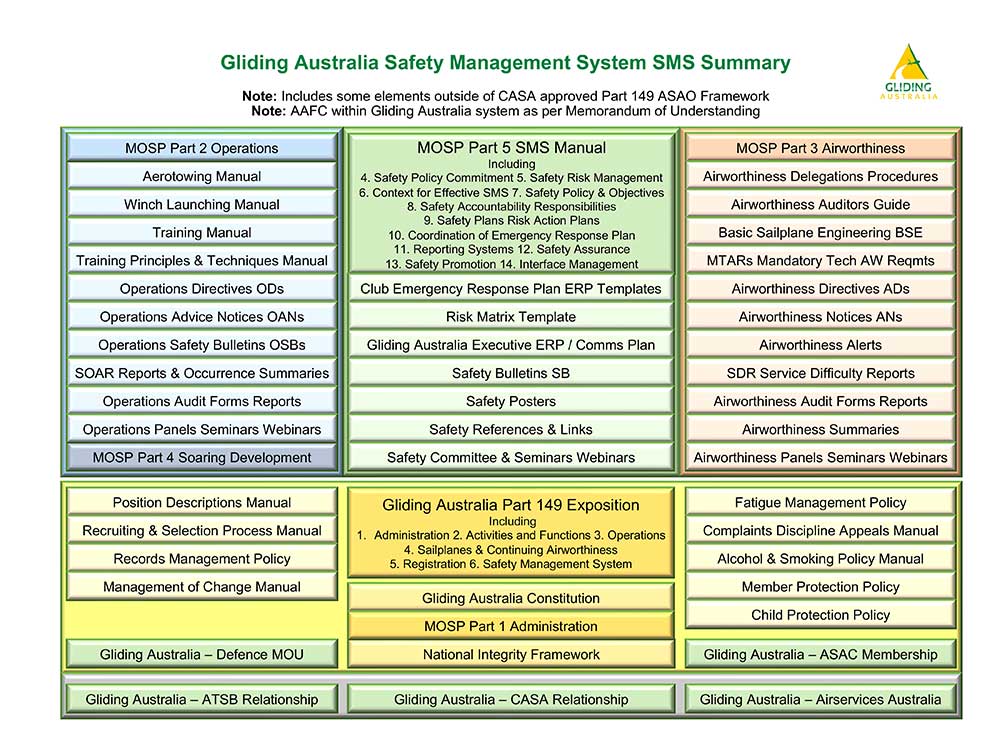
Drew McKinnie
Safety Manager
1.We all want safe operations and airworthy gliders and systems
2.We rely upon many other people in diverse rolesto make that happen.
3.We want to enjoy our sport with minimum overheads and administration at club level.
4.We shun bureaucracy, complexity
and contradictions.
53We prefer intuitive, simple navigation through
rules and manuals
6.We need ready access to essential information
when things go wrong.
7.We prefer guidance that can be tailored
to club and local environments.
and local environments.
Most pilots have a huge interest in preserving their freedom to fly, in getting airborne, and having a great time up there, safely. No scary stuff!
Most pilots have minimal interest in laws, rules, manuals, administration.
Most people I talk to are grateful that someone else is doing administrative stuff, keeping all the Part 149 transition work at arm’s length.
That said, every pilot needs a basic knowledge of what our Safety Management System, SMS, does, and how to access key information to keep themselves safe in the future.
Most people in gliding have great interest in learning from the misfortunes of others, hearing constructive guidance on avoiding or reducing risks.
So, here’s a navigation guide, with a building block diagram.
Aviation safety is governed by laws, regulations and standards. They are hard to navigate. Civil Aviation Regulations, Civil Aviation Safety Regulations, Manuals of Standards and so on, govern our activities. CASA is the regulator.
Gliding Australia now has certain approved functions, defined in CASR Part 149, that allow us to administer gliding activities as an Approved Self-Administering Aviation Organisation (ASAO). Those functions, and compliance obligations, are described in our Part 149 Exposition document.
How do we comply with the regulations and standards, and deliver those approved functions?
That is defined in our Manuals of Standard Procedures, or MOSPs:
MOSP 1 covers our Administrative activities,
MOSP 2 describes our Operations procedures and requirements,
MOSP 3 describes our Airworthiness procedures and requirements,
MOSP 4 covers Soaring Development, sporting activities outside Part 149, and
MOSP 5 describes our Safety Management System. It’s a new MOSP.
MOSP 6 is being drafted, and will cover Marketing and Development activities outside Part 149.
Figure 1 shows a summary block diagram of the SMS and administrative links.
So, what’s in MOSP 5 SMS? That’s the green block in the top centre. The SMS is approved by CASA as meeting Part 149 compliance requirements. To avoid duplication, MOSP 5 SMS has coloured stars to aid navigation – sections with red stars apply to clubs and members, green stars apply to regional associations, blue stars to the national organisation, and gold stars apply to everyone.
The SMS contains the Gliding Australia Safety Policy Commitment, then the context of our organisation, processes for risk management, policy and objectives, accountability and responsibilities at club, regional and national levels. Safety plans, Emergency Response Plans and safety reporting systems are described, then safety assurance, safety promotion, plus our safety links with other organisations.
Where can I find MOSP 5 SMS? In our online documents folders, in both the MOSP folder and Safety Management folder. You will also find templates for Emergency Response Plans (ERPs) for clubs, competitions and events. Clubs, CFIs, Presidents and Safety Officers need to develop club or aerodrome user group versions of these.
The Safety Management folder includes safety links and references, videos, seminars, safety posters, and Safety Bulletins. All important stuff in staying safe, useful for awareness and education, building a positive safety culture.
Gliding Australia does not have a safety department because all departments drive safety – operations, airworthiness, soaring development and all executive functions. So the Exposition and all other MOSPs form part of the SMS, along with their supporting manuals and processes. Everything about how we operate and maintain gliders, train and qualify pilots and maintainers, issue alerts and notices, bulletins and advice, or handle occurrence and defect reports, audits and safety reviews, forms part of the bigger safety system.
That logic also applies to personal safety and wellbeing. The integrity framework manuals that describe member and child protection, smoking and alcohol, fatigue management, complaints discipline and appeals processes, provide an improved framework for member safety.
Under Part 149, CASA also prescribes four key positions – the CEO (Accountable Manager), Safety Manager, Executive Manager Operations and Executive Manager Airworthiness – who perform aviation safety functions. Hence the position descriptions manual, recruiting and selection processes, change management and records management policies also affect how we achieve safety outcomes.
Gliding Australia interacts with other organisations in delivering safe operations – Defence (AAFC), the Air Sport Australia Confederation (ASAC), ATSB, Airservices Australia, and CASA. Those relationships and working groups influence how we maintain and assure safety.
Club officials and individual members can help by promoting a positive safety culture, enhancing information flow between members, building safety awareness, linking constructively with the right people, and using the overall SMS to advantage. It’s not someone else’s problem – everyone’s interests and collective safety are at stake. If all else fails, email































